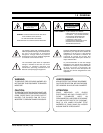
Pelco Manual C651M (7/99) 9
2.0 OVERVIEW
2.1 INTRODUCTION TO TIME-LAPSE RECORDERS
Time-lapse recording permits longer than ordinary recording times. The primary
reason for using time-lapse recording in a CCTV security system is that a single
VCR tape can be used for an extended period of time beyond the standard record-
ing time. The following explains how time-lapse recording works.
The actual recording on VCRs is a series of still pictures or fields. Standard con-
sumer VHS recorders store 60 fields (30 frames) per second. A T-120 cassette
lasts just two hours in this mode (SP mode). You can get slightly longer recording
times (six hours) using the extended recording mode (EP mode). You can record
even longer on a T-160 cassette in these modes: two hours and 40 minutes in SP
mode and eight hours in EP mode. (Refer to the table in Section 8.1.1 for actual
recording times in different modes.)
Time-lapse VCRs, however, use microprocessor-based techniques to record fewer
fields per second than a normal VHS machine and extend recording time. This
negates the need to change the tape every two hours—and also substantially re-
duces viewing time when the recording is played back, another important consider-
ation.
In normal VCR operation all video head scans (60 per second) are recorded. But in
time-lapse mode the tape runs more slowly and records pictures periodically. In 12-
hour mode, a normal time-lapse machine records 10 fields per second and in 24-
hour mode, it stores just five fields per second (for up to 12 and 24 hours on a tape,
respectively). Longer times are possible by slowing the recording rate further.
At normal speed a picture is recorded every 1/60 of a second so there is little
change over five frames. In longer time-lapse modes, however, a field is recorded
intermittently over a longer period of time so changes are apparent from field to
field.
The time-lapse recording can be played back at normal two-hour tape speed, which
makes for rapid review—one of the time-lapse recorder’s most important advan-
tages. Action on the tape, however, appears faster than normal.
As an advanced feature, time-lapse recorders (like the TLR2096) can automati-
cally switch from time-lapse to real-time recording when an alarm condition occurs.
This is important since the primary purpose of recording an event is identification,
and real-time recording provides more detail.
2.2 TLR2096 FEATURES AND FUNCTIONS
The TLR2096 time-lapse video recorder is a powerful surveillance tool designed
for industrial and security recording. In addition to ordinary two-hour (SP – standard
play) and six-hour (EP – extended play) recording modes, its time-lapse modes
permit recording of 18, 72, or 96 hours. (Linear mode is designated as L18H.) The
TLR2096 features frame-by-frame playback and high-speed playback of longer
recordings.
• Audio Recording—Audio recorded in 2H, 6H, or L(inear)18H mode is played
back only in its respective mode.
• Resolution And Image Quality—This VCR has a high-quality circuit allowing
more than 350 lines in B/W (black and white) mode, and more than 300 lines
in color mode.
• Tape Remaining Indicator—A bar indicator shows how much tape is left and/
or that the tape has approximately three minutes (in 2H mode) left.


















